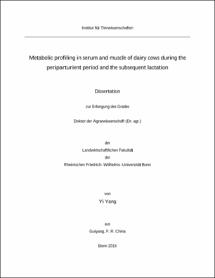Yang, Yi: Metabolic profiling in serum and muscle of dairy cows during the periparturient period and the subsequent lactation. - Bonn, 2018. - Dissertation, Rheinische Friedrich-Wilhelms-Universität Bonn.
Online-Ausgabe in bonndoc: https://nbn-resolving.org/urn:nbn:de:hbz:5n-52995
Online-Ausgabe in bonndoc: https://nbn-resolving.org/urn:nbn:de:hbz:5n-52995
@phdthesis{handle:20.500.11811/7389,
urn: https://nbn-resolving.org/urn:nbn:de:hbz:5n-52995,
author = {{Yi Yang}},
title = {Metabolic profiling in serum and muscle of dairy cows during the periparturient period and the subsequent lactation},
school = {Rheinische Friedrich-Wilhelms-Universität Bonn},
year = 2018,
month = dec,
note = {The transition period in dairy cows, spanning three weeks before and after parturition, is characterized by complex metabolic processes required for the homeorhetic adaptation to the needs of late pregnancy and the onset of lactation. Adaptive failure during the periparturient period may impair animal health and performance. Besides liver and systemic investigations performed in blood, the role of adipose tissue that is mostly affected by the mobilization of body reserves at that time, formed a research focus. Skeletal muscle is the largest organ in the body and is also involved in the adaptive reactions during the transition period, but alterations of metabolic pathways around parturition were scarcely characterized. Therefore, the aim of this dissertation was to characterize the metabolome in skeletal muscle and in serum of dairy cows during the transition from late pregnancy to early lactation. The oxidative capacity for fatty acids (FA) in skeletal muscle may also contribute to reducing the metabolic load of FA, and thus we took the profiles of muscle and blood serum FA esters of carnitine, i.e. the acylcarnitines (ACC) in focus. In addition, a dietary supplementation with conjugated linoleic acids (CLA) was tested for potential effects on the target variables. To achieve the objectives, a targeted metabolomics approach was used in which up to 188 endogenous metabolites from six different compound classes can be quantified. The ACC metabolism was further investigated by assessing the mRNA abundance of carnitine acyltransferases in muscle. Results of this study indicate that FA oxidation, as well as the metabolism of arginine, tryptophan, phosphatidylcholines, and sphingomyelines were the metabolic pathways that were mainly influenced by the transition from late gestation to early lactation. These altered metabolic pathways may reflect dysregulated lipid metabolism, impaired insulin action, and increased inflammatory status in dairy cows around parturition. Furthermore, when combining the results with the data from the mRNA abundance of carnitine acyltransferases, the results also indicate that β-oxidation in muscle mitochondria increased around parturition, but was likely exceeding the capacity of acetyl-CoA utilization in the tricarboxylic acid cycle. The present dissertation adds on to understanding the multifaceted metabolic adaptation of dairy cows during the transition from late pregnancy to early lactation.},
url = {https://hdl.handle.net/20.500.11811/7389}
}
urn: https://nbn-resolving.org/urn:nbn:de:hbz:5n-52995,
author = {{Yi Yang}},
title = {Metabolic profiling in serum and muscle of dairy cows during the periparturient period and the subsequent lactation},
school = {Rheinische Friedrich-Wilhelms-Universität Bonn},
year = 2018,
month = dec,
note = {The transition period in dairy cows, spanning three weeks before and after parturition, is characterized by complex metabolic processes required for the homeorhetic adaptation to the needs of late pregnancy and the onset of lactation. Adaptive failure during the periparturient period may impair animal health and performance. Besides liver and systemic investigations performed in blood, the role of adipose tissue that is mostly affected by the mobilization of body reserves at that time, formed a research focus. Skeletal muscle is the largest organ in the body and is also involved in the adaptive reactions during the transition period, but alterations of metabolic pathways around parturition were scarcely characterized. Therefore, the aim of this dissertation was to characterize the metabolome in skeletal muscle and in serum of dairy cows during the transition from late pregnancy to early lactation. The oxidative capacity for fatty acids (FA) in skeletal muscle may also contribute to reducing the metabolic load of FA, and thus we took the profiles of muscle and blood serum FA esters of carnitine, i.e. the acylcarnitines (ACC) in focus. In addition, a dietary supplementation with conjugated linoleic acids (CLA) was tested for potential effects on the target variables. To achieve the objectives, a targeted metabolomics approach was used in which up to 188 endogenous metabolites from six different compound classes can be quantified. The ACC metabolism was further investigated by assessing the mRNA abundance of carnitine acyltransferases in muscle. Results of this study indicate that FA oxidation, as well as the metabolism of arginine, tryptophan, phosphatidylcholines, and sphingomyelines were the metabolic pathways that were mainly influenced by the transition from late gestation to early lactation. These altered metabolic pathways may reflect dysregulated lipid metabolism, impaired insulin action, and increased inflammatory status in dairy cows around parturition. Furthermore, when combining the results with the data from the mRNA abundance of carnitine acyltransferases, the results also indicate that β-oxidation in muscle mitochondria increased around parturition, but was likely exceeding the capacity of acetyl-CoA utilization in the tricarboxylic acid cycle. The present dissertation adds on to understanding the multifaceted metabolic adaptation of dairy cows during the transition from late pregnancy to early lactation.},
url = {https://hdl.handle.net/20.500.11811/7389}
}






